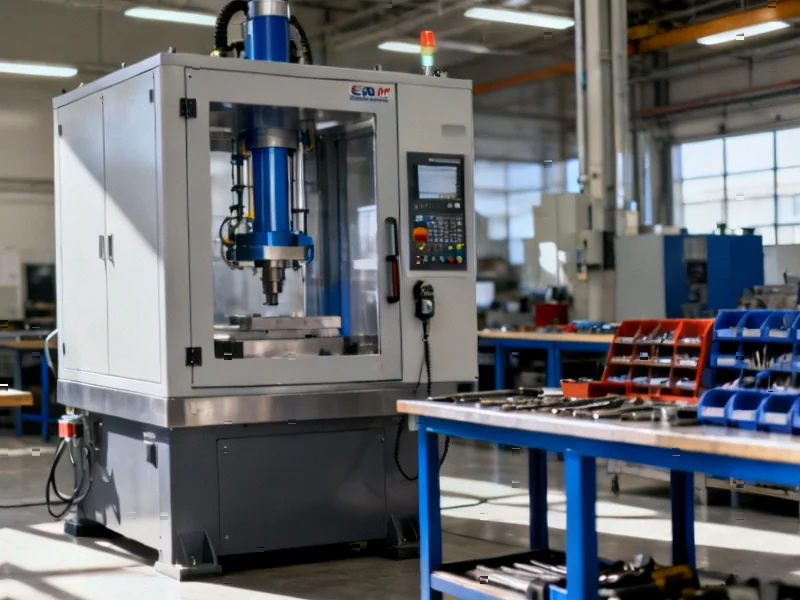According to Manufacturing.net, Promess Inc., a Brighton, Michigan-based manufacturer of adaptive servo-controlled assembly presses and monitoring solutions, showcased its H-Series hazardous location servo press & station at this year’s Assembly Show in Rosemont, Illinois. Designed for mission-critical industrial and defense applications, the system handles materials ranging from powdered metals to reactive substances with force capabilities from 10 to 500 kN and stroke lengths of 330 to 400 mm. The press features closed-loop movement control, data acquisition, and specialized safety measures to prevent explosive particles from entering the cabinet, making it suitable for assembling batteries, fracking materials, and munitions. This represents a significant advancement in manufacturing technology for high-risk environments.
Table of Contents
The Precision Behind Servo-Controlled Manufacturing
What makes the H-Series particularly noteworthy is its application of servomechanism technology in environments where traditional manufacturing equipment would pose unacceptable risks. Servo systems use feedback control to achieve precise positioning and force application, but applying this to hazardous materials requires additional layers of safety engineering. The system’s ability to learn force signatures through a teach-in process means it can be programmed for highly specific manufacturing tasks while maintaining consistent quality control. This level of precision becomes critically important when working with materials where even minor variations in force or positioning could lead to catastrophic failure.
Addressing Manufacturing’s Most Dangerous Applications
The H-Series enters a market segment where safety and precision intersect in ways that most manufacturing equipment never addresses. For industries like defense manufacturing and fracking materials production, the consequences of equipment failure extend far beyond production downtime. The system’s sealed cabinet design represents a fundamental rethinking of how manufacturing equipment interacts with its environment. In traditional manufacturing, particles and contaminants might cause quality issues, but in these applications, they can trigger explosions or chemical reactions. The system’s calibration for both compression and tension work suggests it’s designed for complex assembly processes where materials might need to be both pressed together and pulled apart with equal precision.
Expanding Industrial Automation Into New Frontiers
This development represents a significant expansion of industrial automation into sectors that have traditionally relied on manual processes or less sophisticated equipment. The ability to network multiple part programs and display force and position graphs with zooming capabilities suggests Promess is targeting applications requiring extensive documentation and quality assurance. This is particularly relevant for defense contractors and aerospace manufacturers who must maintain detailed records of manufacturing processes for certification and liability purposes. The system’s data acquisition and storage capabilities could become valuable for companies needing to demonstrate compliance with stringent safety regulations.
Where Promess Fits in the Industrial Equipment Ecosystem
Based in Brighton, Michigan, Promess operates in a specialized segment of the industrial equipment market that bridges the gap between standard manufacturing presses and custom-engineered solutions. The company’s focus on adaptive servo-controlled systems positions it against larger industrial automation players who may offer more generalized solutions. The H-Series specifically targets applications where standard equipment cannot be safely used, creating a niche that larger manufacturers might overlook. The system’s force range from 10 to 500 kN suggests it’s designed for both smaller precision applications and heavier industrial uses, giving it flexibility across multiple market segments.
Critical Factors for Successful Deployment
While the technical specifications are impressive, the real challenge for companies considering this technology will be integration and operator training. Systems operating in hazardous environments require specialized maintenance protocols and safety procedures that go beyond standard manufacturing equipment. The external sensor capabilities for monitoring force, position, flow, pressure, and temperature suggest the system is designed for integration with broader manufacturing processes, but this also increases complexity. Companies will need to consider whether their existing personnel have the expertise to program and maintain such systems, or if they’ll require additional training or specialized hires. The system’s ability to work with reactive materials also raises questions about maintenance procedures and how components are cleaned or replaced without introducing new risks.



